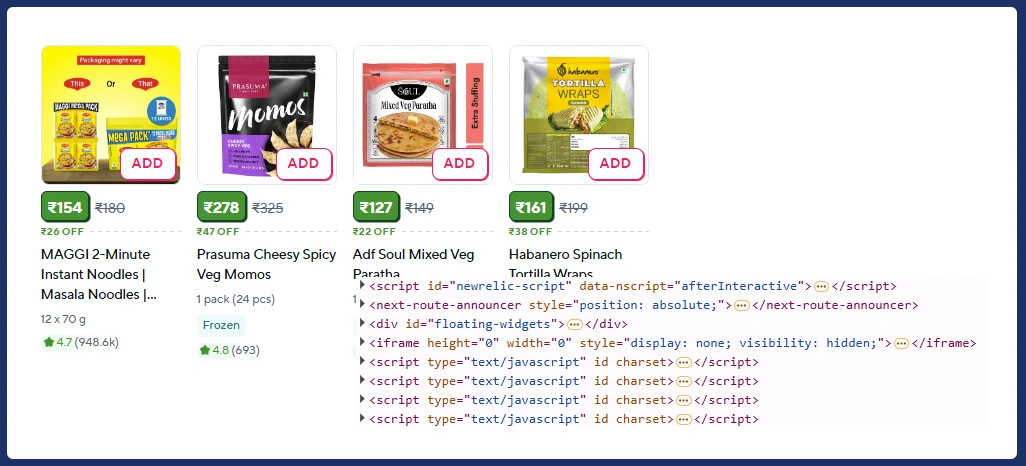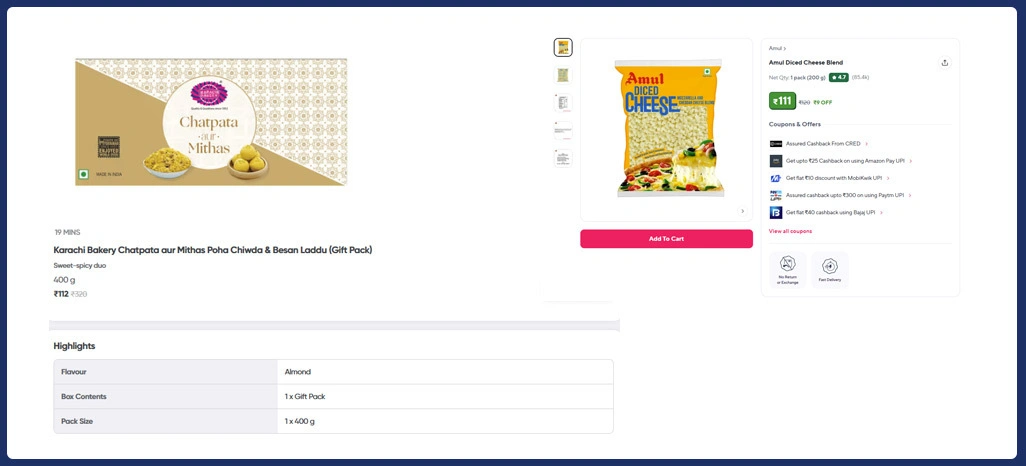How is Pincode-Level Data Collection from Zepto and Instamart Transforming 70% Area Insights?

Introduction
The rise of hyperlocal delivery platforms has reshaped how consumers shop for essentials. With every order placed through platforms like Zepto and Instamart, valuable insights are generated about local consumption trends, preferences, and demand surges across different regions. Businesses aiming to understand these patterns are now turning to Pincode-Level Data Collection From Zepto and Instamart to decode grocery behavior across India.
By collecting and analyzing data at a micro-level, retailers can identify which localities have the highest product movement and which areas reflect changing customer needs. Such granular intelligence enables better inventory planning, strategic pricing, and product placement across neighborhoods. This pincode-level approach is especially vital for brands expanding into tier-2 and tier-3 cities, where shopping preferences vary drastically from metro zones.
When integrated with Quick Commerce Data Scraping, the process allows companies to monitor real-time delivery data and predict short-term fluctuations in consumer demand. As a result, retailers and CPG brands can streamline logistics, fine-tune distribution routes, and strengthen their regional marketing efforts—ensuring their products reach the right shelves at the right time.
Unveiling Micro-Level Grocery Buying Behavior Patterns

Understanding grocery demand at a neighborhood scale is becoming crucial for brands seeking to adapt to rapidly evolving urban consumption habits. As online grocery platforms expand their reach across cities and towns, Grocery Demand Analysis India has become central to identifying what people buy and when they buy it. These localized patterns help brands refine their product offerings, optimize stocking, and enhance regional marketing effectiveness.
Leveraging structured datasets like Instamart Product Dataset allows companies to observe how product categories perform in different regions. For instance, some pincodes show a strong demand for dairy products, while others lean heavily toward packaged foods or beverages. Such variations reveal localized consumer behavior and indicate potential product gaps or oversupply zones that can be corrected through data-backed decision-making.
| Pincode | Top Grocery Item | Average Weekly Orders | Demand Growth (%) |
|---|---|---|---|
| 400001 | Fresh Vegetables | 5,800 | 14% |
| 560076 | Dairy Products | 4,100 | 10% |
| 110017 | Packaged Foods | 6,200 | 18% |
| 600097 | Beverages | 3,900 | 11% |
Analyzing such patterns through Hyperlocal Grocery Data Insights helps brands understand region-specific preferences with remarkable precision. The dataset clarifies where new delivery hubs should be built, how discounts affect order frequency, and which categories require better inventory rotation.
This micro-level understanding lays a solid groundwork for business scalability, helping brands align supply with Pincode-Level Grocery Data and real-time consumer behavior. Gradually, these actionable insights boost customer satisfaction and drive higher profitability.
Strengthening Demand Forecasting Through Localized Analytics

As the grocery delivery ecosystem matures, brands are increasingly relying on hyperlocal intelligence to refine forecasting accuracy and operational responsiveness. By combining Real-Time Grocery Market Data with localized analytics, businesses can measure performance differences across regions and align product flow with consumer expectations. This localized approach transforms static reports into dynamic tools for predictive planning and adaptive pricing.
Integrating advanced automation through Grocery Scraping API simplifies this process by ensuring structured data collection from multiple grocery platforms. It eliminates manual tracking and provides live updates on price fluctuations, category performance, and regional delivery timelines. This helps brands adjust to consumer demand surges faster and identify performance trends across different market segments.
| Region | Category | Order Volume Increase (%) | Price Sensitivity Index |
|---|---|---|---|
| West Zone | Snacks | 13% | 0.7 |
| South Zone | Staples | 17% | 0.9 |
| North Zone | Beverages | 12% | 0.8 |
| East Zone | Frozen Foods | 10% | 0.6 |
The use of Pincode-Based Demand Tracking gives brands an advantage in understanding how small geographic variations impact sales volume. For instance, staple goods might surge in southern regions while ready-to-eat snacks dominate urban clusters.
Incorporating these signals with Hyperlocal Grocery Data Insights enables accurate forecasting, efficient inventory allocation, and the creation of demand responsive delivery models. With such data-driven intelligence, retailers can minimize overstock, streamline routes, and sustain profitability while adapting swiftly to real-time consumption changes.
Enhancing Market Responsiveness with Dynamic Local Strategies

In a competitive retail ecosystem, timing and responsiveness are key to sustaining customer loyalty. By integrating Real-Time Price Monitoring into analytics systems, retailers can detect pricing shifts instantly and adjust their offerings accordingly. This ability to align prices dynamically with consumer trends enhances competitiveness while maintaining profit margins across varied markets.
Evaluating Real-Time Grocery Market Data through region-specific analytics allows retailers to assess their performance metrics more precisely. Hyperlocal observations, such as delivery efficiency and conversion rates, reveal how well each market cluster performs and which adjustments are required for improvement.
| City | Avg. Delivery Time (mins) | Conversion Rate (%) | Price Adjustment (%) |
|---|---|---|---|
| Mumbai | 22 | 78 | +5 |
| Delhi | 25 | 74 | +7 |
| Bengaluru | 19 | 81 | +4 |
| Pune | 23 | 76 | +6 |
With insights powered by Hyperlocal Grocery Data Insights, businesses can map consumption shifts and tailor offers for specific localities. This precision enables companies to align their marketing, delivery, and pricing strategies in real-time, resulting in improved customer engagement and sales growth.
Moreover, incorporating Pincode-Based Demand Tracking ensures efficient distribution routes and optimized operational planning. This synergy between data intelligence and local adaptability helps businesses maintain strong market positioning, ensuring every retail decision reflects accurate consumer realities.
How Retail Scrape Can Help You?
We empower businesses with advanced Pincode-Level Data Collection From Zepto and Instamart solutions designed to deliver granular visibility into local market patterns. Our powerful data extraction framework transforms raw platform data into actionable market intelligence for grocery and retail brands.
With our services, you can:
- Track product availability and pricing variations across multiple pincodes.
- Measure category-wise customer preferences and order frequencies.
- Analyze demand fluctuations to optimize inventory planning.
- Identify untapped areas for brand expansion.
- Build data-backed promotional campaigns for regional audiences.
- Monitor competitor performance at the hyperlocal level.
Using Zepto Grocery Store Datasets, we provide real-time, structured, and compliant datasets tailored to your analytics needs. Whether you’re a grocery aggregator, retailer, or FMCG brand, our pincode-level insights simplify your strategic planning and drive faster execution. With the inclusion of Hyperlocal Insights From Grocery Delivery Apps, We ensure that your decisions are informed, precise, and future-ready.
Conclusion
Localized retail decisions are no longer based on assumptions. Businesses using Pincode-Level Data Collection From Zepto and Instamart are gaining access to region-specific consumption behavior that drives data-backed growth and faster adaptability to market shifts. Such precision enables brands to effectively manage stock flow and respond proactively to changing neighborhood demands.
The use of Zepto and Instamart Grocery Trends enables teams to identify customer engagement opportunities while refining marketing strategies. These granular analytics offer a new lens to decode evolving grocery patterns across India. Partner with Retail Scrape today to start collecting hyperlocal grocery intelligence and elevate your regional retail performance with real-time precision.
